Novel Cooperative Automatic Modulation Classification Using Vectorized Soft Decision Fusion for Wireless Sensor Networks
Abstract
:1. Introduction
- In this work, a new CAMC framework is proposed; it outperformed the conventional single-node AMC approach, especially when individual channel conditions vary significantly.
- A novel vectorized soft decision fusion strategy using the voting mechanism based on the “perturbed” local normalized Hamming-distance sequences at the FC was theoretically derived, which can avoid potential local-decision errors arising from the OHDF mechanisms.
- By integrating the local graph-based AMC scheme at each individual sensing node and the new vectorized soft decision fusion strategy at the FC, we designed a new decision-level CAMC approach for distributed (decentralized) WSNs. Monte Carlo simulations demonstrated its superiority to the existing CAMC approach.
2. System Model
3. The Proposed Novel Cooperative AMC Approach
3.1. Local Graph-Based AMC Scheme
3.2. New Vectorized Feature Fusion Rule
| Algorithm 1: Our proposed new CAMC scheme using vectorized soft decision fusion for WSNs. |
|
3.3. Computational Complexity Analysis
3.4. Transmission-Overhead Analysis
4. Numerical Simulation and Comparative Study
4.1. Effectiveness of Our Proposed CAMC Method
4.2. Performance Comparison between Our Proposed New CAMC Scheme and the Existing Single-Node AMC Methods
4.3. Comparative Study between Our Proposed New CAMC Scheme and the Existing CAMC Method
5. Conclusions
Author Contributions
Funding
Conflicts of Interest
References
- Wang, Y.; Liu, M.; Yang, J.; Gui, G. Data-Driven Deep Learning for Automatic Modulation Recognition in Cognitive Radios. IEEE Trans. Veh. Technol. 2019, 68, 4074–4077. [Google Scholar] [CrossRef]
- Marey, M.; Dobre, O.A. Blind Modulation Classification Algorithm for Single and Multiple-Antenna Systems Over Frequency-Selective Channels. IEEE Signal Process. Lett. 2014, 21, 1098–1102. [Google Scholar]
- Dobre, O.A. Signal Identification for Emerging Intelligent Radios: Classical Problems and New Challenges. IEEE Instrum. Meas. Mag. 2015, 18, 11–18. [Google Scholar] [CrossRef]
- Akyön, F.C.; Alp, Y.K.; Gök, G.; Arikan, O. Deep Learning in Electronic Warfare Systems: Automatic Intra-pulse Modulation Recognition. In Proceedings of the Signal Processing and Communications Applications Conference (SIU), Izmir, Turkey, 2–5 May 2018; pp. 1–4. [Google Scholar]
- Hou, C.; Li, Y.; Chen, X.; Zhang, J. Automatic modulation classification using KELM with joint features of CNN and LBP. Phys. Commun. 2021, 45, 101259. [Google Scholar] [CrossRef]
- Wang, Y.; Wang, J.; Zhang, W.; Yang, J.; Gui, G. Deep Learning-Based Cooperative Automatic Modulation Classification Method for MIMO Systems. IEEE Trans. Veh. Technol. 2020, 69, 4575–4579. [Google Scholar] [CrossRef]
- Shah, M.H.; Dang, X. Novel Feature Selection Method Using Bhattacharyya Distance for Neural Networks Based Automatic Modulation Classification. IEEE Signal Process. Lett. 2020, 27, 106–110. [Google Scholar] [CrossRef]
- Wang, H.; Guo, L. A new method of automatic modulation recognition based on dimension reduction. In Proceedings of the Forum on Cooperative Positioning and Service (CPGPS), Harbin, China, 19–21 May 2017; pp. 316–320. [Google Scholar]
- Ma, J.; Qiu, T. Automatic Modulation Classification Using Cyclic Correntropy Spectrum in Impulsive Noise. IEEE Wirel. Commun. Lett. 2019, 8, 440–443. [Google Scholar] [CrossRef]
- Shih, P.; Chang, D.C. An automatic modulation classification technique using high-order statistics for multipath fading channels. In Proceedings of the 11th International Conference on ITS Telecommunications, St. Petersburg, Russia, 23–25 August 2011; pp. 691–695. [Google Scholar]
- Wu, H.C.; Saquib, M.; Yun, Z. Novel Automatic Modulation Classification Using Cumulant Features for Communications via Multipath Channels. IEEE Trans. Wirel. Commun. 2008, 7, 3098–3105. [Google Scholar]
- Xu, J.L.; Su, W.; Zhou, M. Distributed Automatic Modulation Classification with Multiple Sensors. IEEE Sens. J. 2010, 10, 1779–1785. [Google Scholar] [CrossRef]
- Su, W.; Kosinski, J. Framework of network centric signal sensing for automatic modulation classification. In Proceedings of the International Conference on Networking, Sensing and Control (ICNSC), Chicago, IL, USA, 10–12 April 2010; pp. 534–539. [Google Scholar]
- Sohul, M.M.; Ramkumar, B.; Bose, T. Multiuser automatic modulation classification for cognitive radios using distributed sensing in multipath fading channels. In Proceedings of the 7th International ICST Conference on Cognitive Radio Oriented Wireless Networks and Communications (CROWNCOM), Stockholm, Sweden, 18–20 June 2012; pp. 71–76. [Google Scholar]
- Marković, G.B. Centralized two-stage modulation classification by using networked sensors. In Proceedings of the 24th Telecommunications Forum (TELFOR), Belgrade, Serbia, 22–23 November 2016; pp. 1–4. [Google Scholar]
- Markovic, G.B.; L.Dukic, M. Joint cumulant estimate correction and decision for cooperative modulation classification by using multiple sensors. Ann. Telecommun. 2014, 70, 197–206. [Google Scholar] [CrossRef]
- Hakimi, S.; Hodtani, G.A. Optimized Distributed Automatic Modulation Classification in Wireless Sensor Networks Using Information Theoretic Measures. IEEE Sens. J. 2017, 17, 3079–3091. [Google Scholar] [CrossRef]
- Zhang, Y.; Ansari, N.; Su, W. Optimal Decision Fusion Based Automatic Modulation Classification by Using Wireless Sensor Networks in Multipath Fading Channel. In Proceedings of the IEEE Global Telecommunications Conference—GLOBECOM, Houston, TX, USA, 5–9 December 2011; pp. 1–5. [Google Scholar]
- Yan, X.; Rao, X.; Wang, Q.; Wu, H.C.; Zhang, Y.; Wu, Y. Novel Cooperative Automatic Modulation Classification Using Unmanned Aerial Vehicles. IEEE Sens. J. 2021, 21, 28107–28117. [Google Scholar] [CrossRef]
- Marković, G.B.; Dukić, M.L. Decision Fusion Methods for Automatic Modulation Classification with Multiple Sensors in Multipath Fading Channels. In Proceedings of the International Conference on Smart Technologies (EUROCON), Zagreb, Croatia, 1–4 July 2013; pp. 105–112. [Google Scholar]
- Yan, X.; Feng, G.; Wu, H.C.; Xiang, W.; Wang, Q. Innovative Robust Modulation Classification Using Graph-Based Cyclic-Spectrum Analysis. IEEE Commun. Lett. 2017, 21, 16–19. [Google Scholar] [CrossRef]
- Yan, X.; Liu, G.; Wu, H.C.; Zhang, G.; Wang, Q.; Wu, Y. Robust Modulation Classification Over α-Stable Noise Using Graph-Based Fractional Lower-Order Cyclic Spectrum Analysis. IEEE Trans. Veh. Technol. 2020, 69, 2836–2849. [Google Scholar] [CrossRef]
- Yan, X.; Rao, X.; Wang, Q.; Wu, H.C.; Wu, Y. Novel Cooperative Automatic Modulation Classification by Credit-based Consensus Fusion. In Proceedings of the IEEE International Symposium on Broadband Multimedia Systems and Broadcasting (BMSB), Chengdu, China, 4–6 August 2021; pp. 1–6. [Google Scholar]
- Zhao, Y.; Xu, Y.; Jiang, H.; Luo, Y.; Wang, Z. Recognition of Digital Modulation Signals Based on High-order Cumulants. In Proceedings of the 2015 International Conference on Wireless Communications & Signal Processing (WCSP), Nanjing, China, 15–17 October 2015; pp. 1–5. [Google Scholar]
- Chu, D.; Liao, L.Z.; Ng, M.K.P.; Wang, X. Incremental Linear Discriminant Analysis: A Fast Algorithm and Comparisons. IEEE Trans. Neural Netw. Learn. Syst. 2015, 26, 2716–2735. [Google Scholar] [CrossRef] [PubMed]
- Ji, S.; Ye, J. Generalized Linear Discriminant Analysis: A Unified Framework and Efficient Model Selection. IEEE Trans. Neural Netw. 2008, 19, 1768–1782. [Google Scholar] [PubMed]
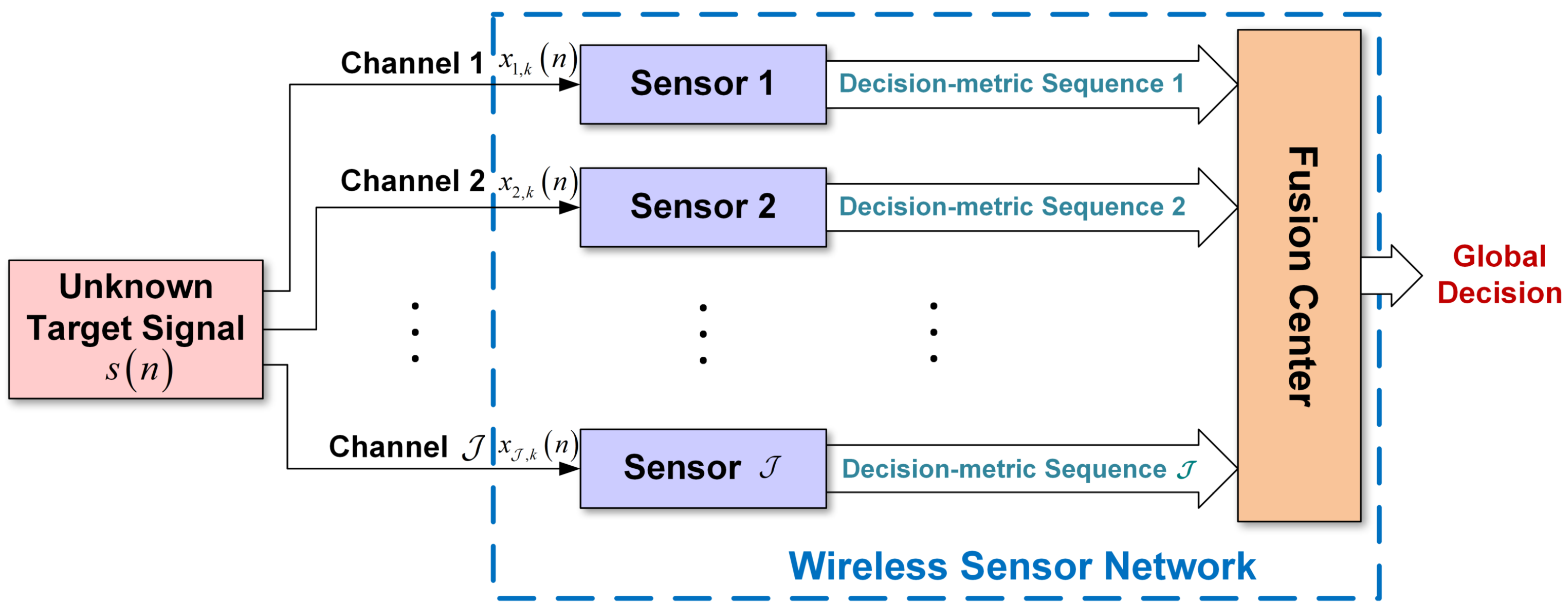
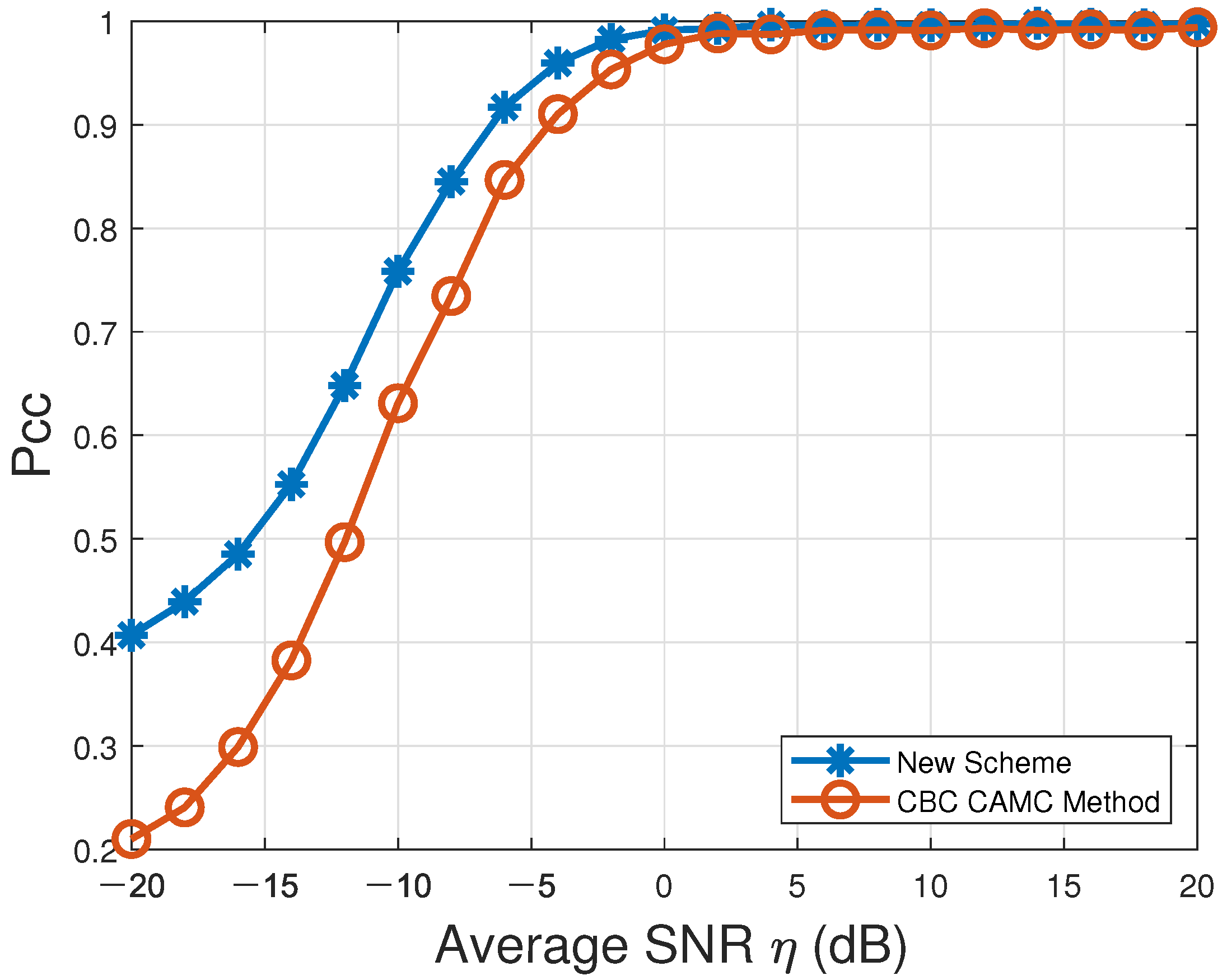
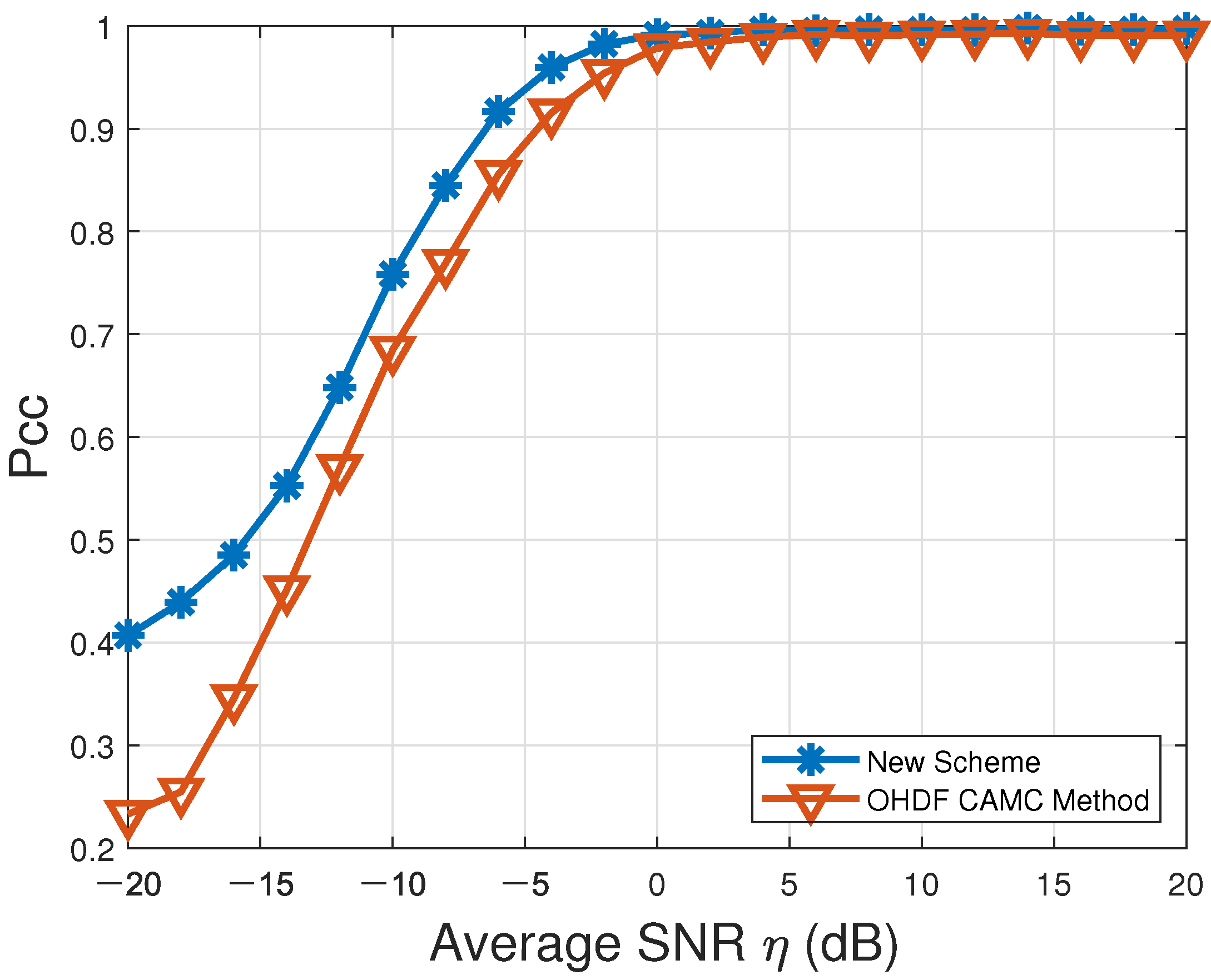
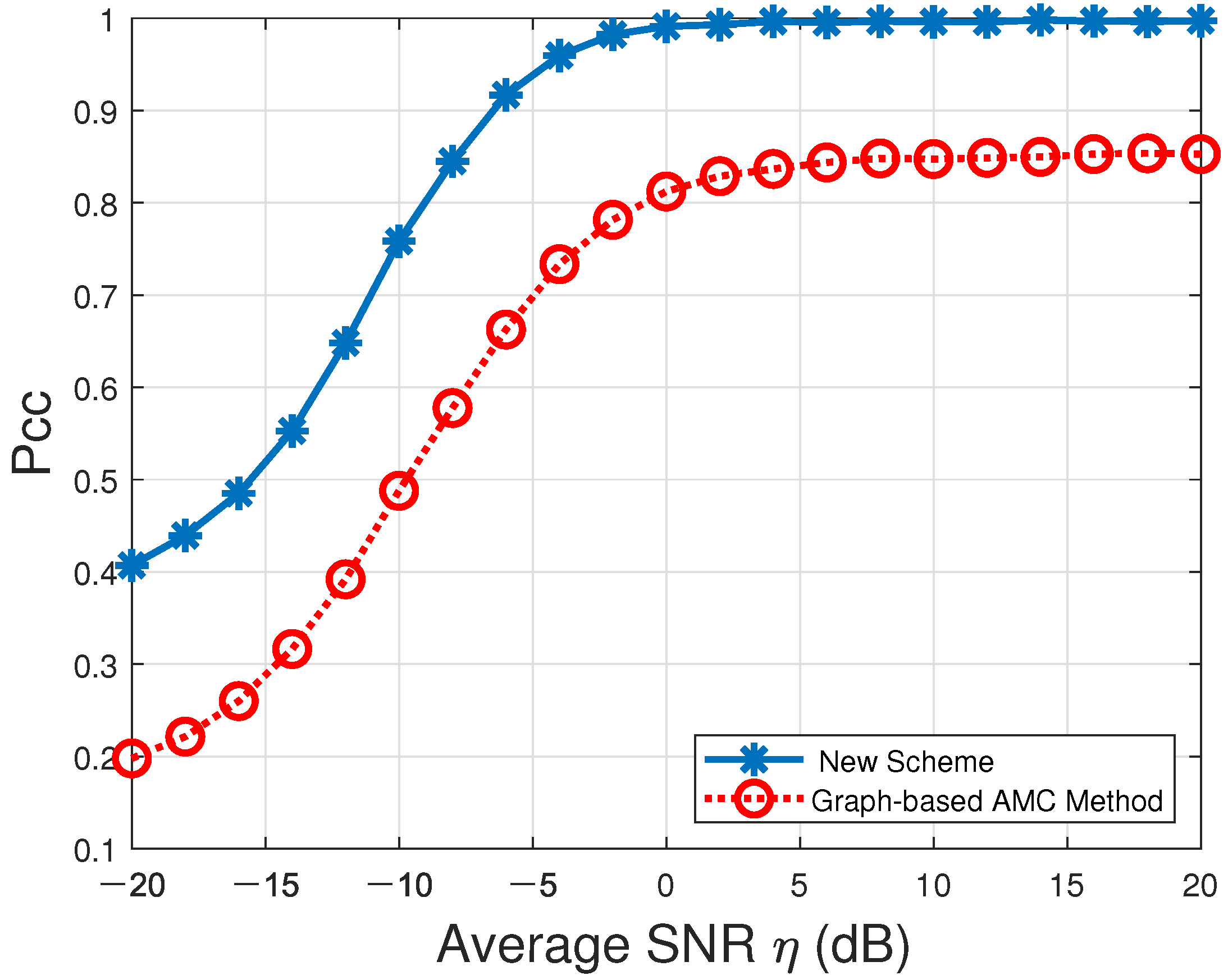
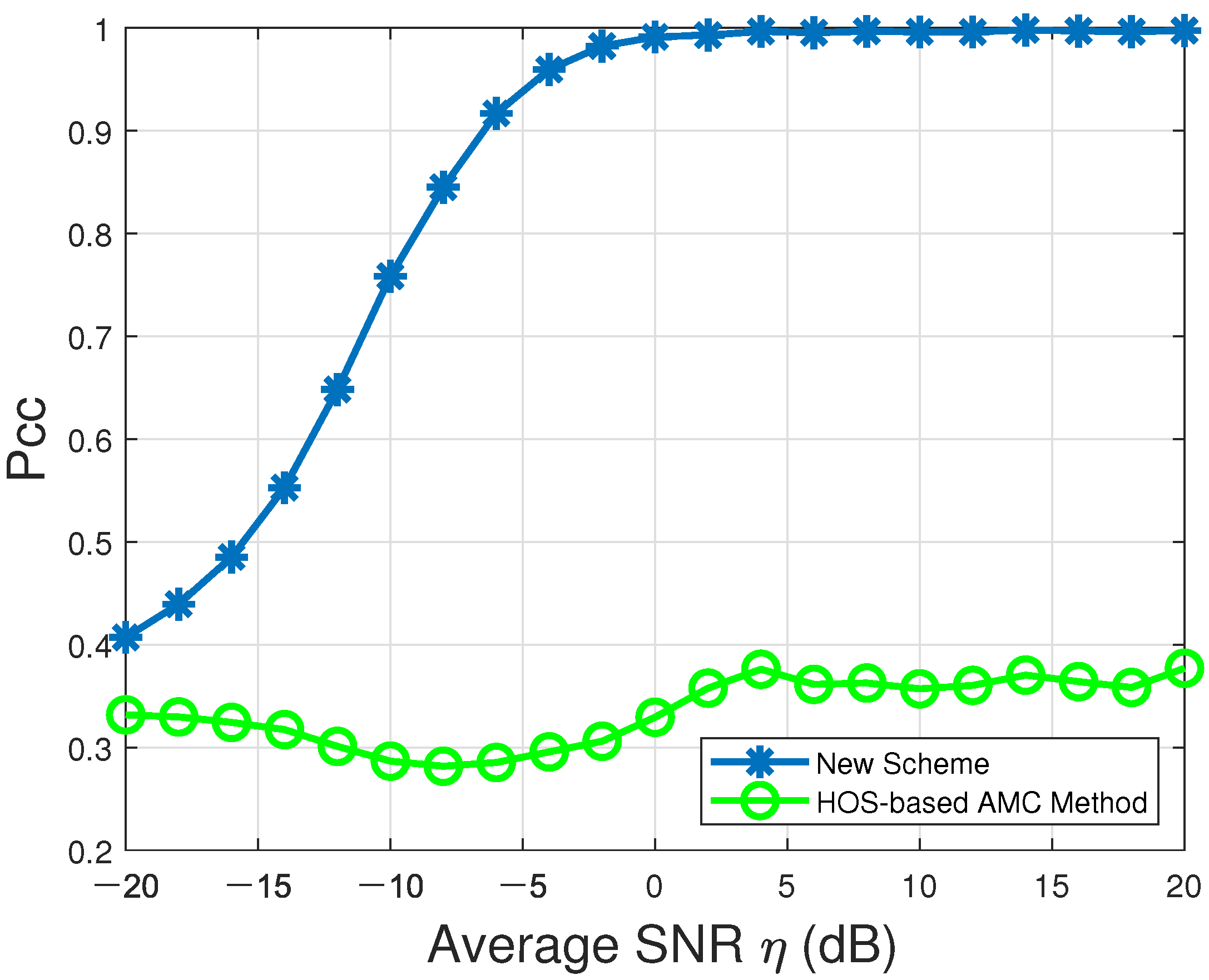
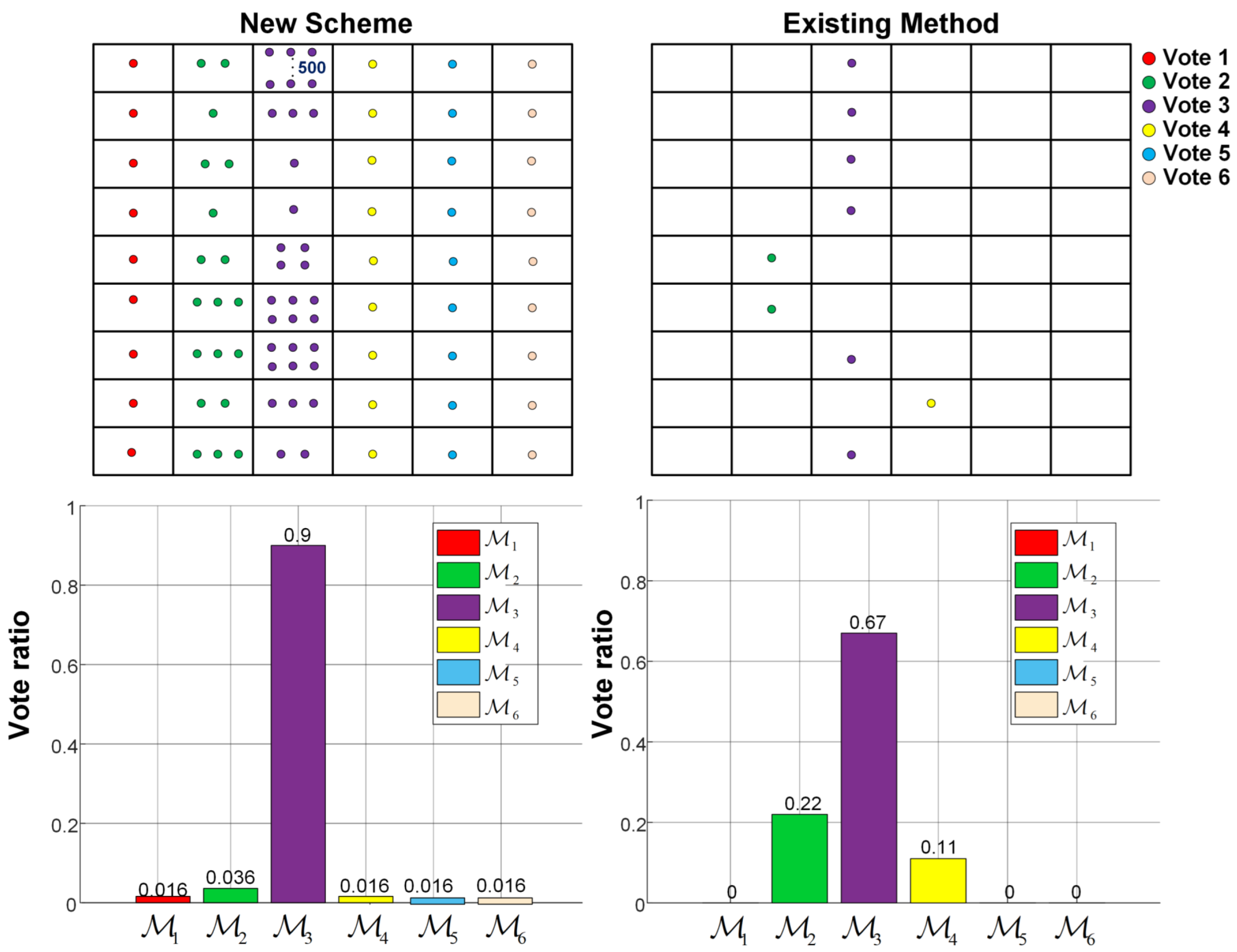
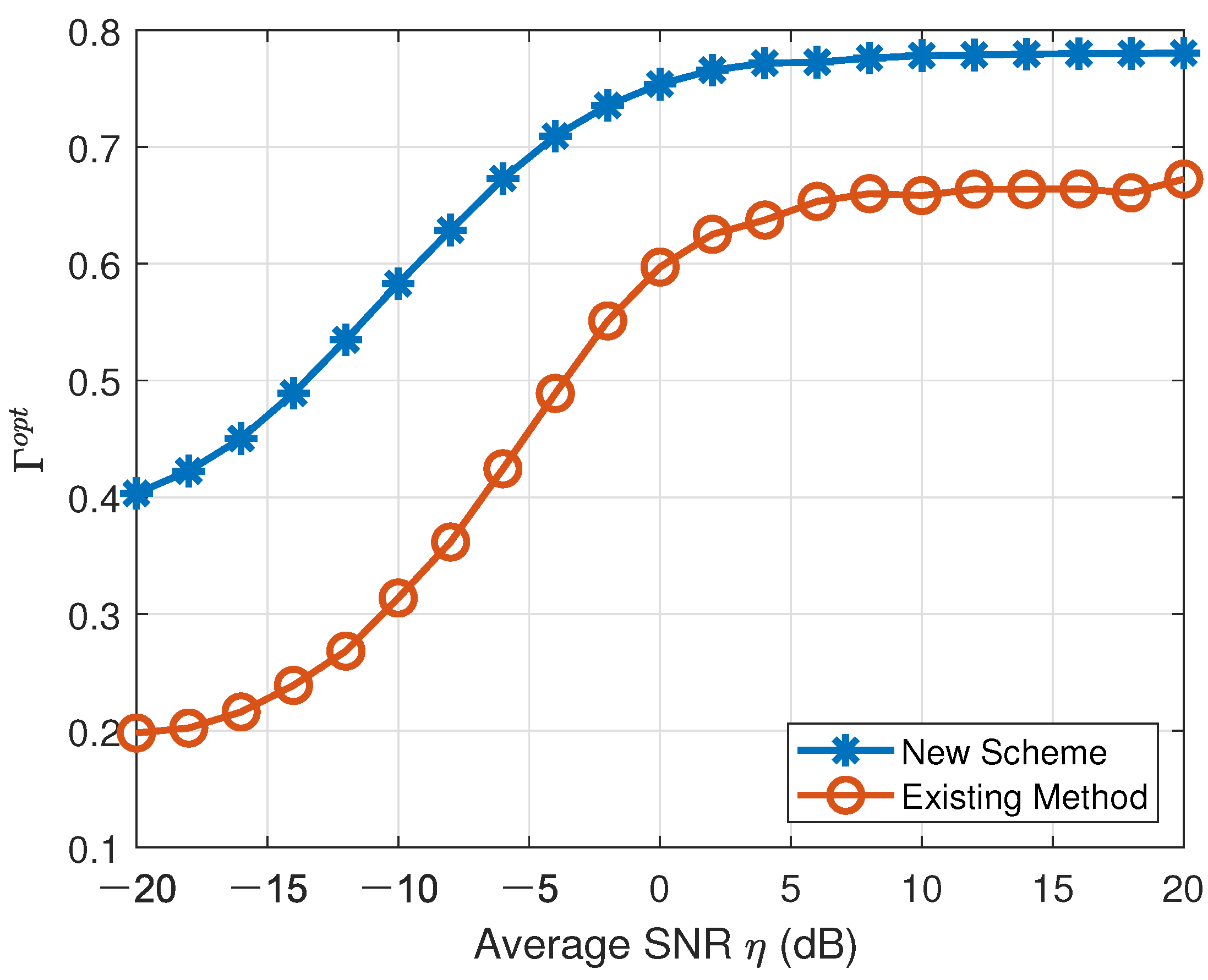
| Method | Constituents | Computational Complexity | Overall Computational Complexity |
|---|---|---|---|
| New VSDF CAMC | Local graph-based AMC | ||
| Individual vote generation | |||
| Soft decision fusion | |||
| Credit-based CAMC | Local graph-based AMC | ||
| Local decision making | |||
| Decision fusion | |||
| OHDF CAMC | Local graph-based AMC | ||
| TFC selection | |||
| Decision fusion |
| New VSDF CAMC | Credit-Based CAMC | OHDF CAMC | |
|---|---|---|---|
| Number of Sensing Nodes | |||
| Number of Modulation Candidates | M | M | M |
| Number of Transmissions |
| Parameters | Path Time Delays (ms) | Path Power Profile (dB) |
|---|---|---|
| Channel 1 | ||
| Channel 2 | ||
| Channel 3 | ||
| Channel 4 | ||
| Channel 5 | ||
| Channel 6 | ||
| Channel 7 | ||
| Channel 8 | ||
| Channel 9 |
| Parameter Setting | Number of Sensing Nodes | 9 | |
| Modulation Candidate Set | BPSK, OQPSK, QPSK, 2FSK, 4FSK, MSK | ||
| Flooring Constant | |||
| FFT Window Size in FAM | 32 | ||
| Sample Size | |||
| Number of Monte Carlo Trials | 1000 | ||
| Average SNR Range | [−20 dB:2 dB:20 dB] | ||
| Simulation Results | Average SNR | for the Proposed CAMC Method | for the Existing CBC CAMC Method |
| Parameter Setting | Number of Sensing Nodes | 9 | |
| Modulation Candidate Set | BPSK, OQPSK, QPSK, 2FSK, 4FSK, MSK | ||
| FFT Window Size in FAM | 32 | ||
| Sample Size | |||
| Number of Monte Carlo Trials | 1000 | ||
| Average SNR Range | [−20 dB:2 dB:20 dB] | ||
| Simulation Results | Average SNR | for the Proposed CAMC Method | for the Existing OHDF CAMC Method |
| Parameter Setting | Parameter | The Proposed CAMC Method | Single-Node Graph-Based AMC |
| Number of Sensing Nodes | 9 | 1 | |
| Modulation Candidate Set | BPSK, OQPSK, QPSK, 2FSK, 4FSK, MSK | BPSK, OQPSK, QPSK, 2FSK, 4FSK, MSK | |
| Flooring Constant | - | ||
| FFT Window Size in FAM | 32 | 32 | |
| Sample Size | |||
| Number of Monte Carlo Trails | 1000 | 1000 | |
| Average SNR Range | [−20 dB:2 dB:20 dB] | [−20 dB:2 dB:20 dB] | |
| Simulation Results | Average SNR | for the Proposed CAMC Method | for Single-Node Graph-Based AMC |
| Parameter Setting | Parameter | The Proposed CAMC Method | Single-Node HOS-Based AMC |
| Number of Sensing Nodes | 9 | 1 | |
| Modulation Candidate Set | BPSK, 2FSK, 4FSK | BPSK, 2FSK, 4FSK | |
| Flooring Constant | - | ||
| FFT Window Size in FAM | 32 | 32 | |
| Sample Size | |||
| Number of Monte Carlo Trails | 1000 | 1000 | |
| Average SNR Range | [−20 dB:2 dB:20 dB] | [−20 dB:2 dB:20 dB] | |
| Simulation Results | Average SNR | for the Proposed CAMC Method | for Single-Node HOS-Based AMC |
| Parameter Setting | Number of Sensing Nodes | 9 | |
| Modulation Candidate Set | BPSK, OQPSK, QPSK, 2FSK, 4FSK, MSK | ||
| Flooring Constant | |||
| FFT Window Size in FAM | 32 | ||
| Sample Size | |||
| Number of Monte Carlo Trails | 1000 | ||
| Average SNR Range | |||
| Simulation Results | Average SNR | for the Proposed CAMC Method | for the Existing CAMC Method |
| dB | |||
| dB | |||
| dB | |||
| dB | |||
| dB | |||
| dB | |||
| dB | |||
| dB | |||
| dB | |||
| dB | |||
| 0 dB | |||
| 2 dB | |||
| 4 dB | |||
| 6 dB | |||
| 8 dB | |||
| 10 dB | |||
| 12 dB | |||
| 14 dB | |||
| 16 dB | |||
| 18 dB | |||
| 20 dB | |||
Publisher’s Note: MDPI stays neutral with regard to jurisdictional claims in published maps and institutional affiliations. |
© 2022 by the authors. Licensee MDPI, Basel, Switzerland. This article is an open access article distributed under the terms and conditions of the Creative Commons Attribution (CC BY) license (https://creativecommons.org/licenses/by/4.0/).
Share and Cite
Yan, X.; Zhang, Y.; Rao, X.; Wang, Q.; Wu, H.-C.; Wu, Y. Novel Cooperative Automatic Modulation Classification Using Vectorized Soft Decision Fusion for Wireless Sensor Networks. Sensors 2022, 22, 1797. https://doi.org/10.3390/s22051797
Yan X, Zhang Y, Rao X, Wang Q, Wu H-C, Wu Y. Novel Cooperative Automatic Modulation Classification Using Vectorized Soft Decision Fusion for Wireless Sensor Networks. Sensors. 2022; 22(5):1797. https://doi.org/10.3390/s22051797
Chicago/Turabian StyleYan, Xiao, Yan Zhang, Xiaoxue Rao, Qian Wang, Hsiao-Chun Wu, and Yiyan Wu. 2022. "Novel Cooperative Automatic Modulation Classification Using Vectorized Soft Decision Fusion for Wireless Sensor Networks" Sensors 22, no. 5: 1797. https://doi.org/10.3390/s22051797
APA StyleYan, X., Zhang, Y., Rao, X., Wang, Q., Wu, H.-C., & Wu, Y. (2022). Novel Cooperative Automatic Modulation Classification Using Vectorized Soft Decision Fusion for Wireless Sensor Networks. Sensors, 22(5), 1797. https://doi.org/10.3390/s22051797







